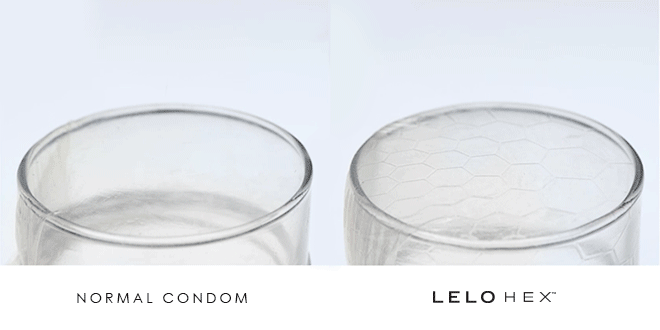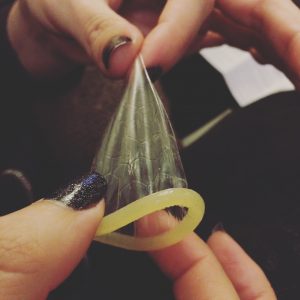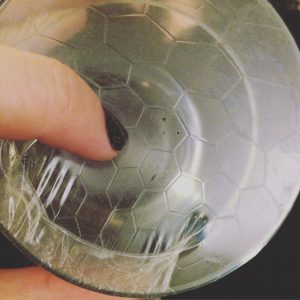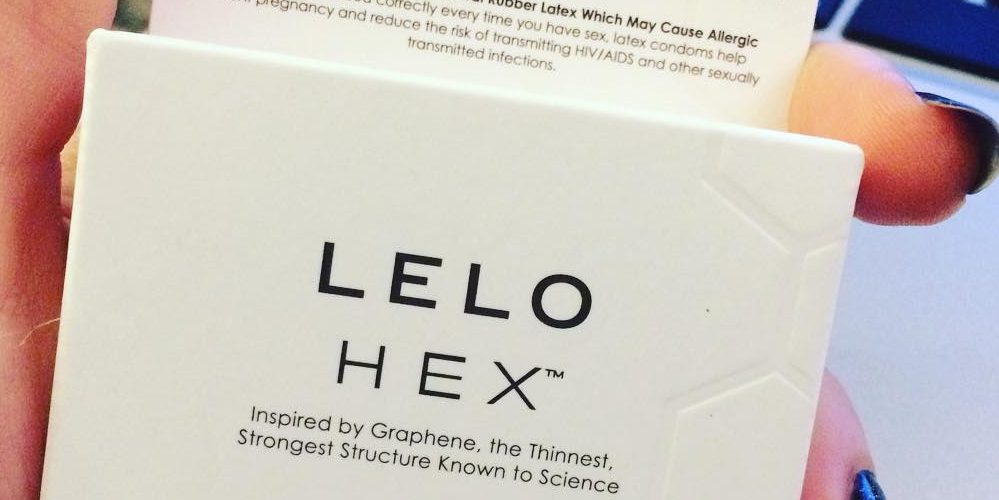I really don’t want to be writing this. Well no, that’s not true. I don’t want to have to write this, but sex education is lacking as it is and far too many people are being rather lackadaisical about the whole thing. Because I can’t in good conscience let condoms which can’t reliably condom be on the market without speaking up. Because I am Not OK with Lelo’s Hex.
 It all began on April Fools Day, at least for most of us. My colleagues and I awoke on the most distrustful day of the year to an email from from “lifestyle-brand” sex utensil manufacturer Lelo announcing Hex, a “revolutionary” new condom. I was, understandably, skeptical but reliable sources reported that no, despite the unfortunate (and somewhat foreshadowing) name it was legit. Lelo was trying something new. Questions abounded: What was going to be different? Will there finally be more non-latex options? Had Lelo teamed up with one of the Bill & Melinda Gates Foundation startups? But Lelo was pretty tight-lipped about the whole endeavour.
It all began on April Fools Day, at least for most of us. My colleagues and I awoke on the most distrustful day of the year to an email from from “lifestyle-brand” sex utensil manufacturer Lelo announcing Hex, a “revolutionary” new condom. I was, understandably, skeptical but reliable sources reported that no, despite the unfortunate (and somewhat foreshadowing) name it was legit. Lelo was trying something new. Questions abounded: What was going to be different? Will there finally be more non-latex options? Had Lelo teamed up with one of the Bill & Melinda Gates Foundation startups? But Lelo was pretty tight-lipped about the whole endeavour.
Until the product launch.
Lelo didn’t so much “launch” Hex, as made an IndieGoGo page to raise money for… well, I’m not even really sure. Hex was already in production. Launch gala attendees were treated to live demonstrations of the condoms features- including “revolutionary” patterning and a base emblazoned with the word “RESPECT” meaning “respect the man who wears it” according to what Gizmodo writer Bryan Menegus was told. This was also when we learned that Charlie Sheen had been selected as the spokesman for the new prophylactic. Now, I’m not even going to go into this bit because while it is a problem a) others have already written about this rather well and b) I am better able to forgive a poor spokesman choice than I am the design/safety issues of Hex.

As I looked through the press-kit Lelo sent me, I was faced with a distressing image. An animated GIF of a stretched-out Hex being repeatedly poked with a pin. Lelo was showcasing a feature of their new condom, which was still latex by the way, that you could poke a hole in it without breaking the it in any noticable way. Read that again. This is an advertised design feature. I am Not OK with this.
 Mysteriously, Lelo sent me a 3-pack of Hex. That same day fellow sex-ed writer Aerie arrived to spend the weekend with me. It was clear that we had to do an unboxing and livetweet/instagram the occasion. Hex was pretty much what I expected- inside each square foil pouch was a standard sized and shaped lubricated latex condom embossed with a hexagonal pattern “inspired by graphene”.
Mysteriously, Lelo sent me a 3-pack of Hex. That same day fellow sex-ed writer Aerie arrived to spend the weekend with me. It was clear that we had to do an unboxing and livetweet/instagram the occasion. Hex was pretty much what I expected- inside each square foil pouch was a standard sized and shaped lubricated latex condom embossed with a hexagonal pattern “inspired by graphene”.
Let’s pause for a moment here to remember what the purpose of a condom is. Scarleteen defines a condom as:
“A thin sheath or tube of latex or another material, worn over the penis during sex to prevent or reduce the risk of pregnancy and/or sexually transmitted infections.”
Most modern condoms are made from polymers (latex, polyisoprene, polyurethane, nitrile, etc.), however condoms have historically been made from the intestinal tract of sheep ((brings a whole new meaning to a sausage party now doesn’t it?)). Beside the squeamy factor of “sheepskin” condoms, as they are kinda incorrectly called, they are also ineffective for one of the two major roles of a condom. Guts have holes in them, tiny pores and the like, which allow them to do their thing while they’re still inside a living being. Great for the sheep, bad for STI protection. They work to reduce pregnancy because on a micro-biological scale, sperm a pretty big ((the head of the average human sperm cell is 3 µm by 5 µm. That’s 0.003mm x 0.005mm. For reference, the smallest the human eye can see unaided is roughly 0.1mm)), and the natural pores of the intestine are small enough to sieve them out while bacteria and viruses are much smaller and easily pass through. What does that have to do with Hex (which I’ll remind you is still boring old latex)?
 Well, I tried their pin-prick test and was horrified to find that the marketing GIF was not a dramatisation. I could indeed pierce Hex several times per region and the condom gave no fucks. “So what?” people retorted. Afterall, isn’t some protection better than none? Aren’t I making raging assumptions that a condom which remains intact despite perforation is worse than a condom which shatters upon puncture? I’m not kidding- these were the arguments that resulted in my Hex experimentations. And no, in this case I’m not so sure that some is better than none, or that any assumption I’m making about the percentages of transmission matter in the least. And here’s why:
Well, I tried their pin-prick test and was horrified to find that the marketing GIF was not a dramatisation. I could indeed pierce Hex several times per region and the condom gave no fucks. “So what?” people retorted. Afterall, isn’t some protection better than none? Aren’t I making raging assumptions that a condom which remains intact despite perforation is worse than a condom which shatters upon puncture? I’m not kidding- these were the arguments that resulted in my Hex experimentations. And no, in this case I’m not so sure that some is better than none, or that any assumption I’m making about the percentages of transmission matter in the least. And here’s why:
While it sucks to have a condom break, the way in which they break acts as, whether intentionally or not, a red flag system. The shattering of the condom means you know that your barrier has failed and that you now need to take steps to address the situation- emergency contraception, STI testing, post-exposure STI prophylaxis (where applicable and available), implementation of barrier methods with otherwise fluid-bonded partners, whatever an instance of exposure means to you. The manner in which Hex fails, however, means the sex act can be completed and there be no sign that there was a breech of security. While we no longer live in a world where contraction of HIV is a guaranteed death sentence, we do live in a world of super gonorrhoea, the Zika virus, and medically resistant syphilis. Pregnancy is still a high-risk medical condition. For a product with “RESPECT” emblazoned up it, Hex doesn’t seem to respect your right to know what’s up when you fuck. Remember that bit I said about microbe size? They make sure to tell you that the box Hex comes in tamper-evident, though. Thanks?
 Maybe this doesn’t bother people because everyone is just numbed to the non-sensical nature of the condom industry. The most widely known brand is named for a sneak-attack, after all. I mean- Trojan? A tale of a perceived peace offering that, once brought inside the city walls poured fourth with men to seize the city? That’s supposed to make me feel safe? And Hex. Really? Hex? I know they meant it as a reference to their silly textured surface (I’ll get to that in a minute) but all I can think of are curses. I’m still left agog at the number of people whose bios include the job title of “sex educator” who have fired back at me on Twitter or Instagram that they don’t understand why I’m upset, or they don’t get why this is a problem. Remember too that this isn’t just a side-effect of the design, this is a built-in feature. Lelo is marketing Hex by showing off that it doesn’t shatter when it develops a hole and apparently people are buying the hype.
Maybe this doesn’t bother people because everyone is just numbed to the non-sensical nature of the condom industry. The most widely known brand is named for a sneak-attack, after all. I mean- Trojan? A tale of a perceived peace offering that, once brought inside the city walls poured fourth with men to seize the city? That’s supposed to make me feel safe? And Hex. Really? Hex? I know they meant it as a reference to their silly textured surface (I’ll get to that in a minute) but all I can think of are curses. I’m still left agog at the number of people whose bios include the job title of “sex educator” who have fired back at me on Twitter or Instagram that they don’t understand why I’m upset, or they don’t get why this is a problem. Remember too that this isn’t just a side-effect of the design, this is a built-in feature. Lelo is marketing Hex by showing off that it doesn’t shatter when it develops a hole and apparently people are buying the hype.
I can’t help but feel like this is hugely irresponsible on Lelo’s part. People who buy these condoms, which retail at $10 for a 3pk, are seeing the name Lelo and recognising it as a leader in the intimacy industry. There is prestige and quality built into the Lelo name. There’s also a bit of tricky wording connected to Hex- “inspired by graphene ((Graphene is actually pretty cool stuff: https://en.wikipedia.org/wiki/Graphene)), the thinnest, strongest structure known to science”. With the Gates Foundation fueling condom research, talk of graphene condoms have been in the news for years. When I started learning more about Hex, even I thought that Lelo must have teamed up with one of the groups working on graphene barriers. But no, Hex is not graphene. Hex is a latex condom with a honeycomb pattern to it and a lot of misleading text on the packaging about graphene. There’s nothing “re-engineered” about them.
 I’m not so sure we need to re-engineer the condom, from a design aspect. Condom design isn’t the reason that people don’t use them anyway. What does need “re-engineering” is sex education, accessibility, and our cultural approach to condoms. Let’s put some of this condom research money into increasing the non-latex condom market and improving availability/accessibility (and yes, possibly more designs) of internal condoms. Let’s put some of that condom research money into actually doing research on condoms for anal sex, because telling folks to “consult [their] healthcare provider for advice” when using barriers for anything other than vaginal intercourse is absurd. And let’s put some of that condom research money, no- let’s put a lot of that condom research money, into improving sex education. That is what will be truly revolutionary and “re-engineer” how people use condoms.
I’m not so sure we need to re-engineer the condom, from a design aspect. Condom design isn’t the reason that people don’t use them anyway. What does need “re-engineering” is sex education, accessibility, and our cultural approach to condoms. Let’s put some of this condom research money into increasing the non-latex condom market and improving availability/accessibility (and yes, possibly more designs) of internal condoms. Let’s put some of that condom research money into actually doing research on condoms for anal sex, because telling folks to “consult [their] healthcare provider for advice” when using barriers for anything other than vaginal intercourse is absurd. And let’s put some of that condom research money, no- let’s put a lot of that condom research money, into improving sex education. That is what will be truly revolutionary and “re-engineer” how people use condoms.




I just had one break on me this morning. Terribly disappointed
Damn, saved me a purchase! Thanks for the informative article!
“If you put a pinhole in it you wouldn’t notice. But are you doing that during normal use?” UM, if you had an abusive partner that wanted to impregnate you, and poked holes in the condom before usage hoping for failure, … this would be a huge problem. I don’t have an abusive partner, but I’ve heard WAY too many stories from other people who have.
Ooookay, so from a structural engineering point of view, the hexagonal ribs do two thing:
* They allow the condom to selectively stretch, increasing sensation. And there’s the whole “ribbed for her pleasure” bullshit.
* They actually make it LESS likely to tear during sexual activity. The condom is reinforced in a way that keeps any one part of if from being stretched too much.
Yes, a Hex condom won’t instantly lose integrity if you poke it with a pin. If you put a pinhole in it you wouldn’t notice. But are you doing that during normal use?
Wow, thank you so much for writing this.
This is a terrible design flaw, I thank you for writing it.
This is prefect for those who want to trick their partners into popping out babies. Yikes. Great article. Thanks!
I appreciate your bringing up this problem. And I like the thoughtfulness. However, not to “poke a hole” in the argument, but neither of our genitals (I’m hoping) are covered in pins.
Friction, in my experience, is what normally breaks a condom. How well does this condom stand to friction? Is that what the “redesign” is about? Is it possible to do a friction test?
I’ll do some more research myself and test one that my wife got me. Sometimes the cheaper condoms fail under stress, so maybe these won’t?
LELO THEMSELVES used the needle-pricking example to advertise a failing of their product as a “feature/benefit.” They said nothing about friction.
Also, condoms are usually applied with fingers. Fingers have fingernails, and hangnails, and rough spots, and these things CAN put pin-sized holes in a condom. Plenty of people also have genital piercings.
Not to mention, that besides fingers/rough patches//hangnails/regular use causing stress and possibly breakage, that in every production run of any condoms there will be an “acceptable” failure rate that a batch of condoms can have and still be considered within their quality standards for retail sale. A certain number of condoms WILL be defective, and every company knows that. This is expected with any manufactured product- it happens before they ever leave the factory. So you could have condoms with undetectable holes or tears before even buying them. Genitals don’t have to be covered in pins for condoms to fail. I would also think that friction could cause similar undetectable failures. The Hex makes it even harder to tell when you have even a large break or tear in a condom, which is never a good thing when trying to protect yourself against STI’s.
Excellent post on a super fucked up product and gimmick. Thanks for testing and writing and sharing.
That royally pisses me off—condom breakage is a warning for the users—it’s like, if someone invented a railroad crossing sign that always said, “Hey, all clear!” EVEN WHEN A TRAIN IS COMING.
It’s just as bad that so many supposed sex-ed teachers see *nothing* wrong with this thing. That tells me right there that either they educated in “abstinence only” as their ONLY “education”… or they’re just plain idiots who should never have gotten a certification.
I’m with you on everything, but as someone with over a decade in the childbirth field, I’ll call you on the “pregnancy is still a high-risk medical condition.” statement. This, right here, is part of why the US has a 33% cesarean rate; because of the inaccurate social narrative that pregnancy defaults to being ‘high-risk’.
Pregnancy is a physiologically normal, biologically designed thing that happens to a person, not a disease. Being pregnant does not magically give you a ‘high risk medical condition’, you are not a ticking timebomb of danger because you are pregnant. Yes, there are things that can cause a pregnancy to *develop* high risk medical conditions, but the vast majority of those are things that are preventable or manageable, rather than immediate, life threatening emergencies.
Pregnancy prevention is a vital, sorely needed topic in this country, but making pregnancy into a scary boogieman shouldn’t be part of the conversation.
Pregnancy is high risk not so much from being pregnant itself but how doctors react to it. The level of unnecessary medical “interventions” is sky high in the US. Much of it from doctors who don’t want to wait for things to go naturally. It’s even worse if you are overweight or obese.
Overuse of medical tools is one of the issues in modern maternity care, to be sure- but that still doesn’t cover calling pregnancy a ‘high risk medical condition.’ Those two things feed into each other. If sex educators call pregnancy a high risk medical condition, then expectant families are more likely to buy into high-intervention care.
The simple fact is, a pregnant person *does* risk severe impairment or death going through pregnancy and delivery… and the rate of death for pregnant people (and infant mortality) is rising in this country… while in countries like Canada, Great Britain, Iceland, and China, the rate of death is *falling* (and our rate is twice or more as high as theirs). Further, the age group we’ve seen the largest increase in deaths in is the “prime time” for pregnancy/delivery: 22-26.
There are numerous reasons the U.S. is going backwards in this.
Some of it is related to doctors/hospitals: everything from the choice of medical procedure, to malpractice (doctor and/or hospital), to patients contracting a disease while in hospital (i.e. MRSA).
Some of it is due to extremely lax regulatory practices in various states, in regard to both birthing centers (facilities not in a hospital), midwives, and duenas. There are literally people out there with zero medical training, and centers that cannot recognize a risk condition developing, who have caused the deaths of both mothers and infants.
THEN there’s the numerous states that have criminalized drug use (including certain prescription drugs) for pregnant people, states that require mandatory testing of the mother’s urine (without notifying her) and immediate reportage to law enforcement if the woman tests positive for *any* amount of illegal drugs, or for prescription drugs that weren’t prescribed by her doctor. There are women who’ve been put in prison for this, and had ALL their children taken from them. In short, this has become a major deterrent for many women to avoid doctor care and hospital delivery altogether—and of course, with no prenatal care or medical supervision, more women and babies will die.
Lastly, there are still many women out there who simply cannot *afford* proper medical care and/or hospital delivery.
Pregnancy and delivery *are* medical procedures, in that the person needs *good* medical monitoring and treatment to (hopefully) have the best outcome possible. Yes, the *odds* are that most people won’t experience life-threatening complications… but to imply the risk is too minor to talk about, is a disservice to all women, because some of us WILL die during it, and a woman ought to have the chance to make an informed, considered decision about that, just as she would if she was having, say, gall bladder surgery or operation on a tumor. In those procedures, we don’t ignore the risk because “we don’t want to make the patient nervous or afraid,” as many doctors say about discussing risk with pregnant women.
The whole “we want to avoid the ‘hysterical reaction'” BS is genuinely that—and, it can put women and their pregnancies at risk. I actually had a female OB/GYN, during an “Okay, you’re pregnant—here’s your do’s and don’ts” totally skip discussing Listeria infections and how to avoid them. When I asked her why, she literally said, “Oh, well we don’t want to frighten our patients.” I was appalled and angered: Listeria infection can cause miscarriage, birth defects, and in some cases might even endanger the woman’s life… and avoiding it boils down to thorough washing of fruits and vegetables, avoiding deli meats and soft cheeses.
When I tasked the doctor with this, she replied, “Well, Listeria infections are so rare… we just don’t think it’s worth it.”
The very next week, I heard on our local radio that deli meats from several local grocery stores were being recalled—because of LISTERIA INFECTION. (It’s actually not that uncommon. A while back Publix had to recall some of their cakes, because the cream cheese in the icing had Listeria in it… and I’ve seen multiple other alerts for Listeria infection in foods, over the years.)
My point is, we need to get over this mindset that a pregnant woman is emotionally fragile and therefore incapable of handling serious topics or discussing health issues that may pose a risk to her or her pregnancy.
We also need to do something about the problems that are causing our mortality rate of women in pregnancy and delivery, and infant mortality rate, to rise.
Thank you so much for the info-rich post.
What exactly is “high-intervention care”? And you said very vaguely that you’re “in the childbirth field” – what exactly is your education and profession? No reason to be vague, since we’re anonymous here.
This is adorable. Check your condoms for holes. Standard procedure.
If the use of “inspired by graphene” confuses you, you are stupid.
And from a business standpoint, making a pretty or unique product is far more important than designing one made for anal, or bolstering sex Ed.
Speaking of that, why is it even remotely Lelo’s problem to teach you about sex?
Wait, you think it’s more important for a company making condoms to make one that is pretty than to make one that actually works?
I’m curious, how closely do you inspect condoms before use? Just a magnifying glass to inspect every part of the condom, or do you pull our your microscope?
Get your facts straight, Benny. He’s planning to inspect them *after* use :D
Can I just say it’s fucking sad you had to explain this? Like, how did the wise folks at LELO, whose products I used to really like, not fucking get this? If a condom breaks that is, like you said, a very abrupt and clear indication that something has compromised your barrier and it will no longer prevent pregnancy or STIs.
TERRIFYING that the friggin condom..no…”condom” stayed put despite having holes. You could literally have sex, finish, and have NO CLUE that something went wrong. Your idea of “safer sex” is compromised without having an indication that your barrier method was faulty. Scary stuff….
Like, how can you see it, and take clear pictures of how freaky bad it is, and the manufacturers were like, you know, this is a great idea!
What next? Safety belts that don’t actually hold your body weight upon impact? Well..they LOOK like they’d work! Must be good enough!!
Nope nope nope nope nope